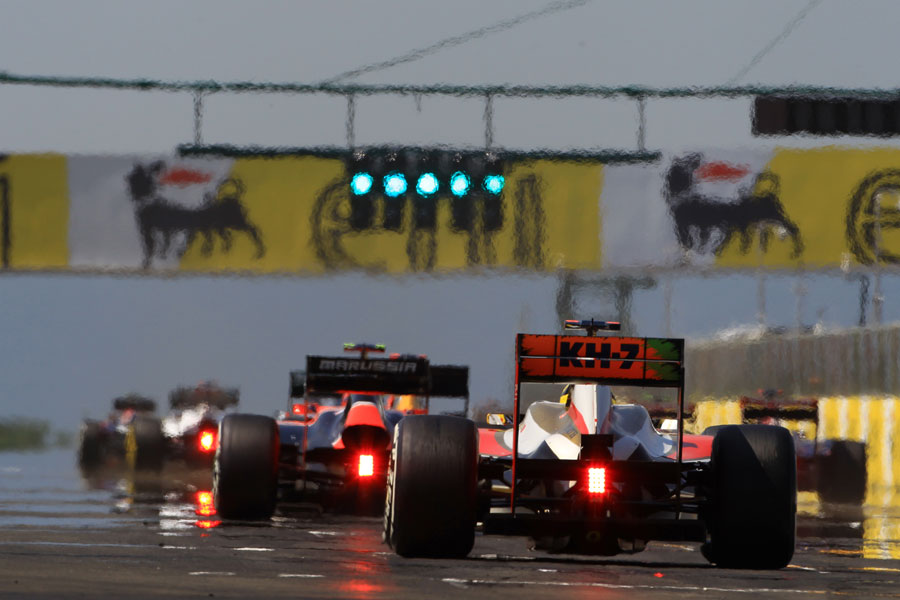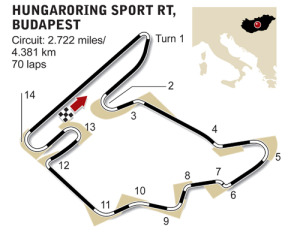GP2 driver Sam Bird gives ESPN his track guide to the Hungaroring ahead of this weekend's race


Before we even tackle the track, it looks like it's going to be a really hot weekend and as a driver you've got to look after yourself. In these conditions you've got to hydrate and eat correctly, because you can dehydrate very quickly without even knowing it and that will affect your performance in these high-end categories of single-seater racing. So the first things for me will be looking after my diet and hydrating myself to the correct levels that I need in order to perform to my best.
Hungary is a high energy circuit in so much as there are hardly any straights; the car is always turning. By the time we get to sector three there's a lot of thermal degradation especially within the rear tyres in GP2. In a race stint it will be very important to look after those rear tyres before sector three on every single lap just making sure that the thermal degradation doesn't come too quickly.
I do have a fond memory of Hungary. The first time I went there was in 2010 and after 30 minutes of practice I put it on pole position - my first ever pole in GP2 - and in fact I think it's still the fastest ever lap in GP2 round there so that's pretty cool.
The first straight is the longest straight on the whole circuit; it rises up and then dips down into the braking point for Turn 1. It's downhill braking, braking at about 100m from sixth down to second gear. On your first lap in qualifying it's quite easy to either lock up or get understeer entering the corner there and if you do that then the lap is pretty much ruined already, but if you set this corner up well and get a good exit then you've made sector one a lot easier for yourself.
Turn 2 then puts a lot of stress through the tyres. You're braking from about 60 or 70m down from fifth down to second gear and it goes on a while. You have to sacrifice the exit a little bit so you can take Turn 3 flat out; you can't use all of the road on the exit of 2 and still get Turn 3 flat out. So you use three quarters of the road on the exit then work really hard to get the car back to the left before firing into the flat out right hander going uphill towards the fast Turn 4.
You need the best possible exit out of Turn 2 because you're climbing uphill after 3. Turn 3 needs to be a difficult flat, it needs to be on the edge. It can't be an easy flat; if you've made it like that then you haven't pushed hard enough through 2. Next you're rising uphill to a blind Turn 4. There's a drain ditch on the right-hand side which is really easy to get your right rear wheel in before turning in to the left, and that can really upset the car. Also the kerb on the apex is very big, so you really don't want to be clobbering that. It's blind; I can't really tell you where the turn-in point is because it's a natural thing you get into.
You use all the kerb on the exit of Turn 4 and then work really hard to get the car back to the left-hand side for the right-hander at Turn 5. There's a lot of run-off at Turn 4 but you can't afford to run wide because the tyre life means you don't have many laps to set a time in. Turn 5 is a long, mid-speed right-hander with a late apex. It's quite bumpy towards the end of the corner and then you head for the slow-speed chicane.
The braking is done at the 50m board for the chicane, it's quite easy to lock the rear tyres here. You take all the kerb on the first part of the chicane and then about half the kerb in the second part before using all of the exit kerb. Then you're into the really busy part and the tyres start to take a battering around this stage of the circuit.
After the chicane you go into a medium speed small left hander - a little brake and down to third gear - which then immediately leads into a right hander so you need good change of direction and you need to work the car very well between the corners. Then again you're into a fast sweeping left hander that is flat out and straight away after that you've got another fast right hander which is a proper corner that requires a little brake and a down change in GP2 from fifth down to fourth.
You've now completed sector two - hopefully the delta time on your display has told you that you're up on your best time - and then it's into the final sector. The tyres are now screaming at you because you've absolutely abused them, so now it's about being controlled and calm and not losing any time in the last three corners.
You're braking at the 100m board for the next right-hand slow speed corner at Turn 12, going from sixth down to second gear. You take just a little bit of kerb on the apex but want to use all of the kerb on the exit and then bring the car back to the right hand side for a small brake from third or fourth down to second gear for the long, slow left hander.
By this point the tyres are really hurting; especially the rears, which you can feel starting to give up a bit. You take a late apex and then you've got one corner to go. It's a little bit like Luffield at Silverstone - a long right hander - but more abrasive. The barrier on the inside isn't a distraction but when you turn in you're hoping that the car will stick and you're hoping that you've got the grip there. The thermal degradation could have escalated, so if the car sticks then great, but if the rears start to move out on entry you know you're in a little bit of trouble. Your whole lap can fall apart in the final sector. You can be thinking "it's good, it's good, it's good" and then you get to the final sector and it might have been a waste of time.
When you're in a race situation, the main overtaking opportunity is going into Turn 1 so getting a good exit from the last corner is vital. Some people will push too hard early in the race and they'll really struggle coming out of the last corner on every lap and they might be extremely vulnerable come the end of the race. Hopefully I won't have such problems and we can put together another strong weekend for Russian Time.
Sam Bird writes for ESPNF1 ahead of every GP2 round
© ESPN Sports Media Ltd.
 Sam Bird writes for ESPNF1 after every World Series by Renault weekend Surrey-based Sam Bird made his name in Formula BMW before working his way through to GP2 where he raced for ART and iSport International. After a year fighting for the title in World Series by Renault he is now back in GP2 with RUSSIAN TIME alongside his duties as a Mercedes test driver
Sam Bird writes for ESPNF1 after every World Series by Renault weekend Surrey-based Sam Bird made his name in Formula BMW before working his way through to GP2 where he raced for ART and iSport International. After a year fighting for the title in World Series by Renault he is now back in GP2 with RUSSIAN TIME alongside his duties as a Mercedes test driver

